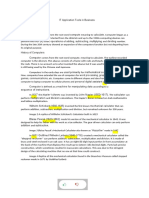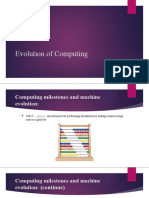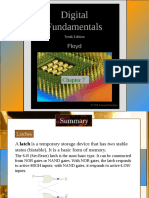Computer History Timeline
Computer History Timeline
Uploaded by
Raly R MunsinCopyright:
Available Formats
Computer History Timeline
Computer History Timeline
Uploaded by
Raly R MunsinCopyright
Available Formats
Share this document
Did you find this document useful?
Is this content inappropriate?
Copyright:
Available Formats
Computer History Timeline
Computer History Timeline
Uploaded by
Raly R MunsinCopyright:
Available Formats
A Computer history timeline Counting aids Manual caculators Mechanical calculators Programmable calculators Programmable computers
Date c.3000 B.C c.1200 A.D c.1600 c.1600 1621 1623 1642 1673 1801-1804 1820 1822-1833 1834 Inventor Babylonians unknown unknown John Napier William Oughtred Wilhelm Schickard Blaise Pascal Gottfried Wilhelm von Leibniz Joseph Jacquard Thomas deColmar Charles Babbage Charles Babbage Device Abacus Chinese abacus Japanese abacus Napiers Bones Slide Rule Shickards Calculator Pascaline Leibniz Calculator Jacquard Loom deColmars Arithometer Difference Engine Analytical Engine Details Simple counting and calculating aid. Thought to have first been invented around this time In widespread use in China by this time (according to textbook) In widespread use in Japan by this time (according to textbook) Multiplication and division tool based on logarithms Similar in purpose and function to Napiers Bones. Based on logarithms also. Popular up until the 1960s. Interlocking geared wheels. Not much known about it. Could add, subtract, multiply and divide. Similar to Pascaline. A mechanical calculating device. Weaving machine that could be programmed with punched cards. First mass-produced mechanical calculator (Never completed) Steam powered. For calculating large tables of numbers for astronomy and engineering. Would have had > 4000 gears levers and wheels. (Never completed) Embodied many of ideas of modern computers: memory, programmable processor, input/output capabilities. Was to use punched cards, probably got that idea from Jacquard. Ada Lovelace (daughter of the poet Lord Byron) also contributed and is considered the worlds first programmer. Punched card tabulating machine created to tabulate results of the 1890 US Census. He incorporated as The Tabulating Machine Company which later became International Business Machines (a.k.a. IBM) First computer prototype to use vacuum tubes instead of mechanical switches. Also used the binary number system like a modern computer. A binary computer. Based on electromechanical relay switches. But working under the Nazi regime in Germany, his work was unknown until much later. Electromechanical relay computer with many moving parts. Used decimal number system. Electronic device made to decode encrypted ENIGMA messages. Made with vacuum tubes and based on binary arithmetic. General purpose computer. Vacuum tubes. Designed to calculate trajectory tables for the US Army, but wasnt finished until shortly after the war. Programmed via switches and patch cables. First commercially successful digital computer. Vacuum tubes. Also used magnetic tape for storage. Took punched cards too. Remington-Rand is the corp that actually marketed and sold UNIVAC, because Eckert-Mauchly ran out of money.
1890
Herman Hollerith
Hollerith Tabulating Machine Altanasoff-Berry Computer (ABC) Z3 Harvard Mark I COLLOSUS ENIAC
1937-1942 ~1942-1945 1939 1943 1943-1945
John V. Atanasoff and Clifford E. Berry Konrad Zuse Howard Aiken (IBM sponsored) A British team incl. Alan Turing John W. Mauchly and J. Presper Eckert Eckert-Mauchly Computer Corp.
1951
UNIVAC
Late 1950s 1965 1965 1965 1971
Various RCA IBM Digital Equipment Corp. (DEC) Ted Hoff (INTEL)
Various RCA Spectra 70 IBM 360 PDP-8 Intel 4004
Second generation computers, based on transistors. One of the first Third Generation Computers based on integrated circuits (IC) Another of the first Third Generation Computers. Based on IC technology. First commercially successful minicomputer (also IC-based) First Fourth Generation Computer, i.e. first microprocessor. That is, the first complete processor on a single chip built using integrated circuit technology. Followed by 8008, 8085, 8080, 8086,8088,80286,80386,80486, 80586 (a.k.a Pentium), Pentium II, Pentium III, Pentium IV. Early predecessor of processor first used in Macintosh computers, the 68000. Based on Intels 8080, versions still used today in embedded computing tasks. Early hobbyist personal computer First truly commercial hobbyist microcomputer. Another early microcomputer kit for hobbyists. Early personal computer with color graphics and actually useful software (VisiCalc) Predecessor of the most popular personal computer platform in use today. First commercial personal computer with a Graphical User Interface (GUI) based on ideas from Xerox PARC research lab. First commercially successful computer with a GUI
1974 1976 1974 1975 1977 1978 1981 1983 1984
Motorola Zilog Jonathan A. Titus Ed Roberts Steve Wozniak and Steve Jobs Steve Wozniak and Steve Jobs IBM Apple Computer Apple Computer
6800 Z80 Mark-8 MITS Altair Apple I Apple II IBM PC Lisa Macintosh
You might also like
- The VLSI Ruby II Advanced Communication ProcessorDocument1 pageThe VLSI Ruby II Advanced Communication ProcessorvlkumashankardeekshithNo ratings yet
- History of ComputerDocument5 pagesHistory of ComputerFawad Umer100% (1)
- Evolution of The ComputerDocument2 pagesEvolution of The Computerrajesh310198867% (3)
- 01 Distribution C FUP1Document4 pages01 Distribution C FUP1Raly R MunsinNo ratings yet
- Error List PDFDocument247 pagesError List PDFClubmasterNo ratings yet
- KTD-00734-J BFlash User ManualDocument19 pagesKTD-00734-J BFlash User Manualsandeep bagulNo ratings yet
- Lesson 2 History of ComputersDocument57 pagesLesson 2 History of ComputersNiña Gel Gomez AparecioNo ratings yet
- History of The Computer1.copy The Important NotesDocument6 pagesHistory of The Computer1.copy The Important NotesJanet DumahilNo ratings yet
- Lada Ada Byron, Countess of Lovelace, Is The FirstDocument3 pagesLada Ada Byron, Countess of Lovelace, Is The FirstCharlie Enjambre HernaniNo ratings yet
- History of Computers ImagesDocument39 pagesHistory of Computers ImageshyynrvNo ratings yet
- History of Computer PDFDocument3 pagesHistory of Computer PDFmark brian BautistaNo ratings yet
- 1st AssignDocument8 pages1st AssignPatricia Joie ClamonteNo ratings yet
- Unit 1Document24 pagesUnit 1VaishNo ratings yet
- Final Summarized History of Computer With ReferencesDocument9 pagesFinal Summarized History of Computer With ReferencesAnene-maidoh Collins IsiomaNo ratings yet
- History of Computing HardwareDocument20 pagesHistory of Computing Hardwareapi-3799532No ratings yet
- History of ComputersDocument31 pagesHistory of ComputersAlthea Dy100% (1)
- Muhammad Faizan (Islamic Studies 2nd)Document5 pagesMuhammad Faizan (Islamic Studies 2nd)princeumair465No ratings yet
- History and Generation of ComputerDocument68 pagesHistory and Generation of ComputerSanjeev KumarNo ratings yet
- It Application Tools in BusinessDocument22 pagesIt Application Tools in BusinessJames Ryan AlzonaNo ratings yet
- History of ComputersDocument12 pagesHistory of ComputersFe Marie JisonNo ratings yet
- History of ComputersDocument14 pagesHistory of ComputersTEENo ratings yet
- Computer HistoryDocument3 pagesComputer HistoryNanda KishoreNo ratings yet
- Early Computing MachinesDocument4 pagesEarly Computing MachinesAndrei BulgaruNo ratings yet
- ... Is Computer HistoryDocument15 pages... Is Computer HistoryyonasminbiyewNo ratings yet
- History of ComputersDocument19 pagesHistory of Computerssaifuddin_ariefNo ratings yet
- History of ComputersDocument7 pagesHistory of Computersadnan shahidNo ratings yet
- Chapter 2 Early To Inventors of ComputerDocument14 pagesChapter 2 Early To Inventors of Computerjanavi kapaseNo ratings yet
- History of ComputerDocument77 pagesHistory of Computersadainsikandar506No ratings yet
- History of ComputerDocument14 pagesHistory of ComputerKimfe VillajuanNo ratings yet
- History of Computers - BulaybulayDocument2 pagesHistory of Computers - BulaybulayLOREN MAE BULAYBULAYNo ratings yet
- Computer History CSSDocument28 pagesComputer History CSSho are yoNo ratings yet
- Chapter 03 History and Classification of ComputersDocument28 pagesChapter 03 History and Classification of Computersshihabsince99No ratings yet
- History of ComputersDocument10 pagesHistory of ComputersChristy HabelNo ratings yet
- Chapter 1Document20 pagesChapter 1Edmund Ayag Jr.No ratings yet
- History of ComputersDocument2 pagesHistory of ComputersLOREN MAE BULAYBULAYNo ratings yet
- Historical Development (Chapter 1)Document7 pagesHistorical Development (Chapter 1)RameshPrasadBhattaNo ratings yet
- ICT AssignmentDocument9 pagesICT Assignmentprinceumair465No ratings yet
- PRESENTATION-History and Evolution of ComputerDocument39 pagesPRESENTATION-History and Evolution of Computeriqrakhan00790% (21)
- AN 3110 Computer Tech PowerPoint LectureDocument61 pagesAN 3110 Computer Tech PowerPoint LectureKshitij PalNo ratings yet
- History of ComputerDocument25 pagesHistory of Computerraffy segocioNo ratings yet
- History of ComputersDocument88 pagesHistory of ComputersLeary John Herza TambagahanNo ratings yet
- History of Computers513Document25 pagesHistory of Computers513Rhenevoi Bastiero NonatoNo ratings yet
- History of ComputerDocument13 pagesHistory of ComputerMALAY BAGHNo ratings yet
- History of Computers513Document25 pagesHistory of Computers513Raquel Bona ViñasNo ratings yet
- History of Computer Part 2Document5 pagesHistory of Computer Part 2Ey KaguriNo ratings yet
- 5ppt Module#03 HistoryAndGenerationsDocument16 pages5ppt Module#03 HistoryAndGenerationsYiannah MarieNo ratings yet
- Computer Architecture and Organization: Unit - IDocument34 pagesComputer Architecture and Organization: Unit - IMegala SubramaniamNo ratings yet
- Assignment in IT 101Document3 pagesAssignment in IT 101chilseybiancaborresNo ratings yet
- Csca0102 Lesson 3 A History of The ComputerDocument36 pagesCsca0102 Lesson 3 A History of The ComputerGOWTHAMRAJNo ratings yet
- History of ComputerDocument13 pagesHistory of ComputerMuhammad HassanNo ratings yet
- History and Evalution of The ComputersDocument6 pagesHistory and Evalution of The ComputersirtazaNo ratings yet
- Educational ComputingDocument17 pagesEducational ComputingJorgie Mae CruzNo ratings yet
- Nursing InformaticsDocument41 pagesNursing InformaticsSarte Rachelle AnneNo ratings yet
- Assignment NO. 1: Prepared By: Bautista, Francheska Annika MDocument8 pagesAssignment NO. 1: Prepared By: Bautista, Francheska Annika MforsytheNo ratings yet
- COMPUTER NOTES ModifyDocument39 pagesCOMPUTER NOTES Modifyjonny2019420No ratings yet
- History and Generation of ComputerDocument22 pagesHistory and Generation of ComputerRaj SwapnilNo ratings yet
- Computer HistoryDocument47 pagesComputer HistoryDianne Princess Marie Joy Batongbakal Y RealondaNo ratings yet
- The History of Computers: Aileen Joyce Soriano 10-HebrewDocument88 pagesThe History of Computers: Aileen Joyce Soriano 10-HebrewRod Rafael De LeonNo ratings yet
- Number System and EthicsDocument20 pagesNumber System and Ethicslyricssad057No ratings yet
- Introducing Computer SystemsDocument95 pagesIntroducing Computer SystemsJethro GamadNo ratings yet
- Evolution of ComputingDocument21 pagesEvolution of ComputingMelx UbaldeNo ratings yet
- History of ComputersDocument7 pagesHistory of ComputersRose Chu0% (1)
- Subject of SWOT AnalysisDocument2 pagesSubject of SWOT AnalysisRaly R MunsinNo ratings yet
- EDF Example of A Financial AuditDocument4 pagesEDF Example of A Financial AuditSantosh SinghNo ratings yet
- PTMC (Cne)Document10 pagesPTMC (Cne)Raly R Munsin60% (5)
- COA GTU Tutorial Solution Part 1Document4 pagesCOA GTU Tutorial Solution Part 1HarmanjotSinghBhatia50% (2)
- Logic Gates ActivityDocument5 pagesLogic Gates ActivityKAYLEIGH YOUNG (Student)No ratings yet
- DLC Exp5 Student Manual-RevisedDocument6 pagesDLC Exp5 Student Manual-RevisedPial Hassan ChowdhuryNo ratings yet
- QuizDocument6 pagesQuizBảo Lê MinhNo ratings yet
- Unit V - 3BCD Ripple CounterDocument13 pagesUnit V - 3BCD Ripple CounterThiriveedhi SubbarayuduNo ratings yet
- Final Project Report RiscDocument25 pagesFinal Project Report RiscAbhinandan AbhiNo ratings yet
- Solution To TestDocument6 pagesSolution To Testkitana_sectNo ratings yet
- Unit 1 - Computer SystemDocument8 pagesUnit 1 - Computer SystemAkashNo ratings yet
- TAIAN TP02 Series: HMI SettingDocument2 pagesTAIAN TP02 Series: HMI SettingEdson Roberto de Fabio GrandaoNo ratings yet
- H27UAG8T2M DatasheetDocument51 pagesH27UAG8T2M DatasheetvictortddNo ratings yet
- Contoh Program Led Arduino UnoDocument4 pagesContoh Program Led Arduino UnoBrillian PerdanaNo ratings yet
- EMI Lab#6Document3 pagesEMI Lab#6Muhammad HamzaNo ratings yet
- Fire h8sDocument78 pagesFire h8scarver_uaNo ratings yet
- Isbat Computer Organisation and ArchitectureDocument73 pagesIsbat Computer Organisation and ArchitectureEden HolyNo ratings yet
- LogDocument12 pagesLogmhmdikhsn970No ratings yet
- Chapter 7Document42 pagesChapter 7Karan KumarNo ratings yet
- Iphone6 Plus PDFDocument55 pagesIphone6 Plus PDFAixa Rosa Parada OropezaNo ratings yet
- 3.1 Introduction To Embedded SystemDocument3 pages3.1 Introduction To Embedded SystemManojkumar ChinnaNo ratings yet
- 74HC4002 74HCT4002: 1. General DescriptionDocument17 pages74HC4002 74HCT4002: 1. General DescriptionJim LiebNo ratings yet
- Application NoteDocument24 pagesApplication NotePopovici Paul100% (1)
- Compal Confidential: Schematics Document Mobile Arrandale rPGA989 With Intel PCH (Ibex Peak-M) Core LogicDocument55 pagesCompal Confidential: Schematics Document Mobile Arrandale rPGA989 With Intel PCH (Ibex Peak-M) Core LogicDeilyn RivasNo ratings yet
- Micro Proccesor Practical Course - Plan EC8681Document2 pagesMicro Proccesor Practical Course - Plan EC8681Raja PirianNo ratings yet
- Slot29 CH18 MultiCoreComputers 18 SlidesDocument18 pagesSlot29 CH18 MultiCoreComputers 18 Slidestuan luuNo ratings yet
- CAMABIO SM25 SpecificationDocument13 pagesCAMABIO SM25 SpecificationArif IftakherNo ratings yet
- Lab Report #1: Digital Logic Design EEE241Document17 pagesLab Report #1: Digital Logic Design EEE241Abdullah ShafiqueNo ratings yet
- Hardware Memory Management For Future Mobile Hybrid Memory SystemsDocument11 pagesHardware Memory Management For Future Mobile Hybrid Memory SystemsMansoor GoharNo ratings yet
- What Is A Full Adder?: Block DiagramDocument5 pagesWhat Is A Full Adder?: Block DiagramAbcdNo ratings yet





























































































